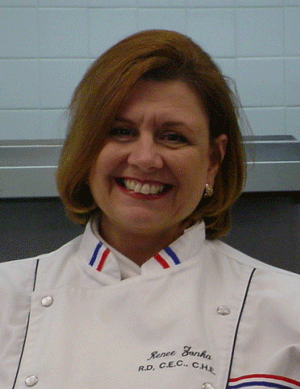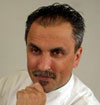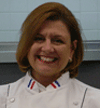Renee Zonka
Associate Dean of Culinary Arts at Kendall College
Registered Dietitian, Certified Executive Chef and Certified Hospital Educator
|
 |
For over 70 years, Kendall College has been offering engaging, specialized fields of study with a strong emphasis on immersive learning that is geared to your academic, personal, and professional success. Learn more about Kendall's rich history
Whether you choose Kendall's acclaimed School of Culinary Arts, world-renowned Les Roches School of Hospitality Management, innovative School of Business, or well-established School of Education, you are encouraged to explore your talents, interests, and passions-and to discover a wealth of exciting opportunities.
Located in Downtown Chicago
In 2004, Kendall College relocated from the near suburbs to our current location along the Chicago River at Goose Island. After a $50-million dollar renovation, our Riverworks Campus finally opened with LEED certification as a green building. The campus is a reclaimed, 100-year-old factory building, most recently home to a Sara Lee research facility.
Affiliations
Kendall College is a subsidiary of Laureate International Universities, a global network of 30 institutions of higher learning in 18 countries with more than 70 campuses including online. Through this partnership, we are able to offer students unprecedented access to global education, internships, and professional opportunities in Europe, Latin America and Asia.
Strawberry Bavarian Pie
Yield: 9 inch pie
Servings: 8 slices
- ½ cup water, cold
- 2 ½ tsp gelatin
- ½ cup sugar
- ¾ # Strawberries
- 8 oz. Silken Tofu, soft, GF
- 8 oz. Vegetarian Cream cheese, GF
- ¼ cup Crème de Cassis
- ¾ tsp vanilla, GF
- ¾ tsp lemon juice, fresh squeezed
- 1 Prebaked 9” Pie Crust
Garnish: Chopped toasted pistachio, sliced strawberries and melted strawberry jelly
Method:
- In small pot, add water, sprinkle gelatin over water and let sit 3 minutes until the gelatin is dissolved. Add sugar and stir. Heat over low heat until the sugar and gelatin are dissolved and syrupy. Let cool slightly.
- In blender, add strawberries. Blend until berries are pureed. Add tofu, vegetarian cream cheese, crème de cassis, vanilla, and lemon juice. Blend until smooth. Add sugar syrup, gelatin mixture. Blend until smooth. Pour into prepared pie crust. Refrigerate at least 12 hours.
- Garnish with sliced strawberries, toasted chopped pistachios and drizzle melted strawberry jelly (in saucepan, melt strawberry jelly with water until syrupy)
Yield: 1 (9”) single crust
- 3 tbsp. butter, frozen
- 2 tbsp. vegetable shortening, frozen
- ¼ cup Sweet White Rice Flour
- ½ cup Sorghum Flour
- ½ cup tapioca Flour
- 1 tsp. xanthan gum
- ¼ tsp. salt
- ¼ tsp. GF baking powder
- 3 tbsp. ice water
Method:
- In bowl, place dry ingredients. Mix.
- Take the butter from the freezer and place in bowl of dry ingredients. Cut the butter into the flour mixture to the size of large chunks. Then, add the shortening and continue cutting in the fats until the size of large peas.
- To the flour/fat mixture, sprinkle the ice water a tablespoon at a time. Using a fork to mix after each addition. Pull the dough together into a ball and knead about 15 seconds. Wrap in plastic and let rest about 30 minutes.
- Roll out dough between two layers of plastic wrap or wax paper. The dough should be about 1” larger than a 9” pie tin. Carefully, remove the top layer of plastic wrap leaving the underlayer of plastic wrap on the dough. Invert your pie tin on top of the uncovered dough. Flip the pan over (now the dough has the plastic wrap on top) and gently fit the dough into the pie tin. Then, remove the other layer of plastic wrap. (Doing this will help the dough to go into the pan easily without breaking or sticking)
- Crimp the sides of the dough for an edge. Prick the inside of the crust with a fork. Bake at 400 degrees or until lightly brown about 18 minutes. Cool.
Yield: 4 cups
- 1 cup Potato flour (or more if needed)
- 1 ½ cups Sorghum flour
- ¼ cup White Rice Flour
- ¼ cup Millet Flour
- ¾ tsp Salt
- 1/8 tsp Black Pepper, freshly ground
- 3 ea Egg whites, slightly whipped
- 12 oz Beer, gluten free*
Method:
- In a large bowl, place potato flour
- In another large bowl, mix remaining flours, salt, pepper, egg whites and beer. Stir until mixed.
- Lightly coat foods to be fried in potato flour, shaking off excess. Place on a cookie sheet.
- When ready to fry, dip food items in batter, shake off excess. Fry until done and golden brown. Drain on paper towel.
*Note: If beer is not desired, can substitute sparkling water.
Interview with Marlisa Brown MS RD CDE CDN Creator of Gluten Free Easy and Author of Gluten-Free Hassle Free,
and Renee Zonka, RD, CEC, CHE and Associate Dean of Culinary Arts at Kendall College
Question: It is fabulous that you are both a Registered Dietitian and a Chef, what inspired you to secure such an exciting career?
Answer: Early on in my youth, I was always interested in cooking. I had a catering business through college and then decorated wedding cakes as side money. In college, I was in a food and nutrition program where I saw the advantage of marrying the two disciplines. The biggest impact for me to see the important blend of the two was during my experience as a renal dietitian. When counseling dialysis patients, it was difficult to limit their food intake and see their disappointment as if I was taking their last bit of enjoyment. I began thinking of ways to make their limited food delicious. I started having cooking classes for patients and their families. I saw a renewed happiness in the patients and family members to eating and social ability. It was very rewarding to me. From then on, I always believed that food, flavor, satiety, enjoyment and compliance to dietary needs in that order are important.
Question: What made you interested in gluten-free cuisine?
Answer: When I was teaching at The Culinary Institute of America, I sat in a presentation on Celiac Disease by a local chapter. It was presented to the students for the purpose of educating them to the needs of a special community. They wanted to impress on them to develop recipes, menus and restaurant possibilities for the future. Another aha! moment for me to combine culinary and nutrition for the satisfaction of someone with special needs. Now, I need to take that to a higher level and bring it to future chefs. When I began teaching at another culinary school in Chicago, I started a Culinary Nutrition class. I dedicated 10 hours a quarter to gluten-free education.
Question: Have you ever followed a gluten-free diet, if so why and how did you find it?
Answer: No. I did have myself tested though. I had been presenting at a 3 day conference and ate gluten free. I started to feel better. I didn’t know if I was gluten intolerant or just part of the group influence. The results of my test was negative.
Question: How does the school teach it's students about gluten-free cooking?
Answer: At Kendall College, we have two classes that teach specifically to gluten-free foods. It is a nutritional cooking class and a healthy baking class. The students are given a lecture on the intolerance and they prepare recipes that are gluten free. All culinary classes have information about allergies and intolerances. We feel it is important for them to understand the significant ramifications of not following the needs of their guests whether for health or business.
Question: Are there programs or culinary opportunities for the public to partake in gluten-free cooking at the school?
Answer: Occasionally, I give presentations to the public on GF cooking but I explain that we are not GF. Therefore, I don’t feel comfortable having a hands-on class.
Question: What do you feel is the biggest obstacle in gluten-free cooking?
Answer: In foodservice, it is difficult to dedicate space for just preparing GF foods. The cross contact issue is huge. The kitchen, wait staff, cashier and management has to be well educated on this. Good intentions only go so far. In a busy kitchen it is easy to make a mistake. People trust what we say and we better stand behind that promise. To be successful with this, everyone must know the content of ingredients in the recipes, how it was handled and prepared.
Question: What are your favorite gluten-free culinary tips that you would like to share?
Answer: When making a standard recipe into a gluten-free recipe, think of the ingredient function. As example, to make a pie crust—fat is cut into flour for tenderness, water is added to bind and not overwork the gluten in the flour, salt is added for flavor. In a gluten-free pie crust, modifications are made to tenderize the crust and lift for flakiness. The fat is cut into large chunks, baking powder is added to help lift the gluten-free flour and xanthan gum is added to keep the dough together. Salt is still added for flavor.
Another tip I give, is not to overwork the doughs or batters. Since the gluten-free flours and gums are high in starch, they have a tendency to get very sticky and gummy.
Question: Where do you see the future for gluten-free cuisine?
Answer: I think gluten-free cuisine is exploding. Products hit the market at a staggering rate. As customers demand more gluten-free menu items, restaurants are starting to listen. They are building out space for gluten-free food preparation, they are purchasing frozen prepared products, or purchasing from an outside source. I see the fast food industry providing more food items for their guests.
Chef Renee Zonka, RD, CEC, CHE
Associate Dean of Culinary Arts at Kendall College
Renee Zonka, Associate Dean of Kendall College, is a Registered Dietitian, Certified Executive Chef, and Certified Hospitality Educator. She has over 30 years of combined experience in clinical and administrative arenas within dietetics and culinary including an Executive Chef position at Christ Hospital, Chef Manager/General Manager position with Marriott Management Services and Instructor at Culinary Institute of America/Hyde Park, New York.
As Associate Dean at Kendall, she teaches a wide range of culinary courses and administrative duties to assess the curriculum and faculty. A Mundelein College graduate, Chef Zonka has a masters degree in business administration, and is a chapter author of the Nutrition Competency Guide, published by the National Restaurant Association Educational Foundation.
In 2006, Renee received the distinguished Chef Educator of the Year award from the American Culinary Federation Windy City Professions Chefs. She is actively involved the gluten free/Celiac groups in education, consulting and recipe development.
Contact Renee at: rzonka@kendall.edu
| Past Featured Authors/Chefs: | |||










